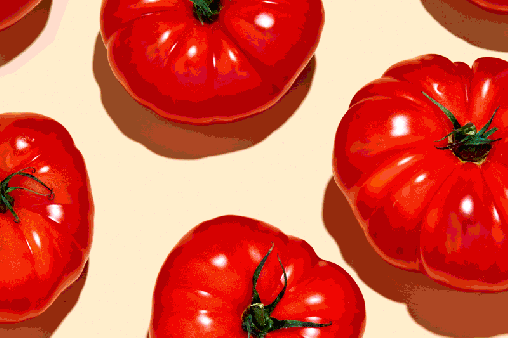
- Gif courtesy of giphy.com
And if you focus on leading a local diet, then you are more likely to actually eat fresh fruits and vegetables. Because locally farmed foods do not come from large commercial food companies, you automatically eat less processed food, which usually contains lots of preservatives, sugar, and other gross junk.
So eating locally is actually good for you — plain and simple. Next time your grocery shopping take a second to think about where your produce comes from — do you really want to eat a mango that’s traveled thousands of miles?
Because local farmers do not rely on crops that have been bred for higher yield or transportation ease, local farmers can place higher value on plant varieties that are more nutritious — thanks to their variety.
So, why is eating locally better for you?
Well, fruits and vegetables lose their nutritional value as soon as they’re picked, so the quicker you eat the produce, the more nutrients you absorb. In fact, some vegetables can lose 15-55% of vitamin C within a week of being picked, and spinach can lose 90% of vitamin C within the first 24 hours post-harvest.
And guess what — because less nutrients are lost from the food during transit, local food actually tastes better, too. When the food arrives at farmers’ markets, food co-ops and other locations, it tastes fresh because the crops are picked at their peaked. Plus, the food spends way less time being transported and sitting in warehouses, which makes it even fresher.

- Gif courtesy of giphy.com
And if you focus on leading a local diet, then you are more likely to actually eat fresh fruits and vegetables. Because locally farmed foods do not come from large commercial food companies, you automatically eat less processed food, which usually contains lots of preservatives, sugar, and other gross junk.
So eating locally is actually good for you — plain and simple. Next time your grocery shopping take a second to think about where your produce comes from — do you really want to eat a mango that’s traveled thousands of miles?

- Gif courtesy of giphy.com
Because local farmers do not rely on crops that have been bred for higher yield or transportation ease, local farmers can place higher value on plant varieties that are more nutritious — thanks to their variety.
So, why is eating locally better for you?
Well, fruits and vegetables lose their nutritional value as soon as they’re picked, so the quicker you eat the produce, the more nutrients you absorb. In fact, some vegetables can lose 15-55% of vitamin C within a week of being picked, and spinach can lose 90% of vitamin C within the first 24 hours post-harvest.
And guess what — because less nutrients are lost from the food during transit, local food actually tastes better, too. When the food arrives at farmers’ markets, food co-ops and other locations, it tastes fresh because the crops are picked at their peaked. Plus, the food spends way less time being transported and sitting in warehouses, which makes it even fresher.

- Gif courtesy of giphy.com
And if you focus on leading a local diet, then you are more likely to actually eat fresh fruits and vegetables. Because locally farmed foods do not come from large commercial food companies, you automatically eat less processed food, which usually contains lots of preservatives, sugar, and other gross junk.
So eating locally is actually good for you — plain and simple. Next time your grocery shopping take a second to think about where your produce comes from — do you really want to eat a mango that’s traveled thousands of miles?
So first, what does it mean to eat locally?
Well, local food has travelled about 100 miles from its source, sometimes slightly more depending on availability. On the other hand, the average, not local dinner travels 1,500 miles from its source to your plate.

- Gif courtesy of giphy.com
Because local farmers do not rely on crops that have been bred for higher yield or transportation ease, local farmers can place higher value on plant varieties that are more nutritious — thanks to their variety.
So, why is eating locally better for you?
Well, fruits and vegetables lose their nutritional value as soon as they’re picked, so the quicker you eat the produce, the more nutrients you absorb. In fact, some vegetables can lose 15-55% of vitamin C within a week of being picked, and spinach can lose 90% of vitamin C within the first 24 hours post-harvest.
And guess what — because less nutrients are lost from the food during transit, local food actually tastes better, too. When the food arrives at farmers’ markets, food co-ops and other locations, it tastes fresh because the crops are picked at their peaked. Plus, the food spends way less time being transported and sitting in warehouses, which makes it even fresher.

- Gif courtesy of giphy.com
And if you focus on leading a local diet, then you are more likely to actually eat fresh fruits and vegetables. Because locally farmed foods do not come from large commercial food companies, you automatically eat less processed food, which usually contains lots of preservatives, sugar, and other gross junk.
So eating locally is actually good for you — plain and simple. Next time your grocery shopping take a second to think about where your produce comes from — do you really want to eat a mango that’s traveled thousands of miles?

- Gif courtesy of giphy.com
So first, what does it mean to eat locally?
Well, local food has travelled about 100 miles from its source, sometimes slightly more depending on availability. On the other hand, the average, not local dinner travels 1,500 miles from its source to your plate.

- Gif courtesy of giphy.com
Because local farmers do not rely on crops that have been bred for higher yield or transportation ease, local farmers can place higher value on plant varieties that are more nutritious — thanks to their variety.
So, why is eating locally better for you?
Well, fruits and vegetables lose their nutritional value as soon as they’re picked, so the quicker you eat the produce, the more nutrients you absorb. In fact, some vegetables can lose 15-55% of vitamin C within a week of being picked, and spinach can lose 90% of vitamin C within the first 24 hours post-harvest.
And guess what — because less nutrients are lost from the food during transit, local food actually tastes better, too. When the food arrives at farmers’ markets, food co-ops and other locations, it tastes fresh because the crops are picked at their peaked. Plus, the food spends way less time being transported and sitting in warehouses, which makes it even fresher.

- Gif courtesy of giphy.com
And if you focus on leading a local diet, then you are more likely to actually eat fresh fruits and vegetables. Because locally farmed foods do not come from large commercial food companies, you automatically eat less processed food, which usually contains lots of preservatives, sugar, and other gross junk.
So eating locally is actually good for you — plain and simple. Next time your grocery shopping take a second to think about where your produce comes from — do you really want to eat a mango that’s traveled thousands of miles?
Over the past few decades, our food culture in the United States has dramatically changed, and people are placing convenience and money over their health.
But it’s time to change these food practices — and local food is the answer.

- Gif courtesy of giphy.com
So first, what does it mean to eat locally?
Well, local food has travelled about 100 miles from its source, sometimes slightly more depending on availability. On the other hand, the average, not local dinner travels 1,500 miles from its source to your plate.

- Gif courtesy of giphy.com
Because local farmers do not rely on crops that have been bred for higher yield or transportation ease, local farmers can place higher value on plant varieties that are more nutritious — thanks to their variety.
So, why is eating locally better for you?
Well, fruits and vegetables lose their nutritional value as soon as they’re picked, so the quicker you eat the produce, the more nutrients you absorb. In fact, some vegetables can lose 15-55% of vitamin C within a week of being picked, and spinach can lose 90% of vitamin C within the first 24 hours post-harvest.
And guess what — because less nutrients are lost from the food during transit, local food actually tastes better, too. When the food arrives at farmers’ markets, food co-ops and other locations, it tastes fresh because the crops are picked at their peaked. Plus, the food spends way less time being transported and sitting in warehouses, which makes it even fresher.

- Gif courtesy of giphy.com
And if you focus on leading a local diet, then you are more likely to actually eat fresh fruits and vegetables. Because locally farmed foods do not come from large commercial food companies, you automatically eat less processed food, which usually contains lots of preservatives, sugar, and other gross junk.
So eating locally is actually good for you — plain and simple. Next time your grocery shopping take a second to think about where your produce comes from — do you really want to eat a mango that’s traveled thousands of miles?





